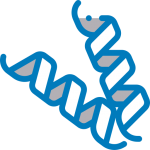
 Hamster PCSK9 Protein, His Tag
Hamster PCSK9 Protein, His Tag
PC9-H52E4
50ug
Brand
ACROBiosystems
Description
Source :
Hamster PCSK9, His Tag (PC9-H52E4) is expressed from human 293 cells (HEK293). It contains AA Gln 30 – Ser 691 (Accession # G3GTK5).
Molecule : PCSK9
Synonyms : PCSK9,FH3,HCHOLA3,LDLCQ1,NARC1,PC9
Format : Powder
Category : Bio-Markers & CD Antigens
Accession : N/A
Storage : -20℃
Shipping condition : Powder,RT
Molecular Weight : 13.9 kDa and 59.0 kDa
Characteristics :
This protein carries a polyhistidine tag at the C-terminus. This protein undergoes autocatalytic cleavage to release the pro-peptide and mature chain. The pro-peptide and mature chain are associated through non‑covalent interactions and with a calculated
Endotoxin Level : Less than 1.0 EU per μg by the LAL method.
Buffer : PBS, pH7.4
Description :
Proprotein convertase subtilisin/kexin type 9 (PCSK9) is also known as NARC1 (neural apoptosis regulated convertase), is a newly identified subtilase belonging to the peptidase S8 subfamily. Mouse PCSK9 is synthesized as a soluble zymogen, and undergoes autocatalytic intramolecular processing in the endoplasmic reticulum, resulting in the cleavage of its propeptide that remains associated with the secreted active enzyme with a broad alkaline pH optimum. This protein plays a major regulatory role in cholesterol homeostasis. PCSK9 binds to the epidermal growth factor-like repeat A (EGF-A) domain of the low-density lipoprotein receptor (LDLR), inducing LDLR degradation. PCSK9 may also have a role in the differentiation of cortical neurons. Mutations in this gene have been associated with a rare form of autosomal dominant familial hypercholesterolemia (HCHOLA3).
References :
(1) Seidah NG, et al., Proc. Natl. Acad. Sci. U.S.A. 100 (3): 928–33.
(2) Abifadel, M. et al., 2003, Nat. Genet. 34: 154-156.
(3) Dubuc G. et al., 2004, Arterioscler. Thromb. Vasc. Biol. 24 (8): 1454–9.
Application
Reactivity



